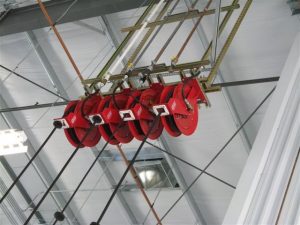
In addition to safety benefits from keeping hoses off the shop floor, hose reels allows a shop to buy lubricant products in bulk, yet still deliver fluid to each bay as needed.
For years, overhead hose reels have been a staple of vehicle service garages.
“The main reason for using hose reels is to keep hoses off the garage floor,” observes Zhang, director of petroleum equipment service distributor sales at PULI Industrial, a manufacturer of lubrication equipment, fluid control systems, pumping products and technical service. “With technicians and customers walking around the bays, lubricant and air hoses on the floor could present a major tripping hazard.
“In addition to safety benefits, using hose reels allows a shop to buy lubricant products in bulk, yet still deliver fluid to each bay as needed.”
He says there are a number of advantages of buying in bulk, including lower cost of fluids, no empty bottles or drums to dispose of or recycle and more productive technicians with convenient access to lubricant products.
CHIEF CONCERNS
When purchasing reels, there are several points to consider, says Zhang. Firstly, all reels look the same when they are new with an attractive coat of paint on steel. However, the strength of a reel is what is inside.”
Of all the equipment in a maintenance shop, he says reels may receive the most abuse, as they continually are extended and retracted. “Many times the retraction is without control. Each extension and retraction wears on the main spring which, if not properly chosen for the lubricant – high, medium or low pressures – will suffer premature wear and possibly breakage.
“The lever and spring that lock the reel spool in place during use also are susceptible to wear,” he says. “Be certain both of these items are sufficient in strength and design to handle the application.
“Look for a spool or sheave that is solid, not just pins that the hose wraps around. Without a solid base, the small pins that some manufacturers use will put a kink in the hose, restricting flow and causing premature wear.
“Confirm that the inlet and outlet swivels are appropriate for your fluids and pressures, and look for swivels that have unions that do not kink the hose as you install it.”
HOSE ISSUES
The hose that comes with the reel is critical, emphasizes Zhang. “Be certain the hose cover is compatible with the fluids to which it will be exposed. Verify that the hose cover is smooth and wraps easily around the reel spool.
“Do not be deceived about the reel’s strength based upon the outlet arms. The actual strength of the reel is in the design, not the appearance. A single-arm reel can be just as strong as a dual-arm reel if properly designed.
“Consider a skyscraper when the wind blows. The structure sways ever so slightly to keep it from breaking. A single-arm reel does the same, giving slightly as you extend the hose to allow dissipation of the pressure on the reel.”
Single-arm reels allow for hose replacement or tension adjustment without removing the valve – a time saver when action is required, Zhang points out. Many shops choose a dual-arm reel, preferring the appearance and extra stability it provides at the hose outlet.
“When properly selected, both single-arm and dual-arm reels will work comparably.”
“Reels, when properly positioned and chosen, provide a safer, more profitable and more productive workplace,” says Zhang. “Select your reel based upon your actual requirements and its cost of ownership – not by its looks and price tag.